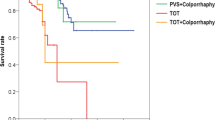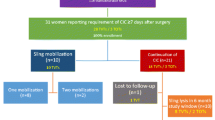Abstract
Purposes
Midurethral synthetic sling (MUS) placement via either the retropubic or transobturator route is the standard surgical procedure for women with stress urinary incontinence. However, a small portion of patients experienced voiding dysfunction after the surgery, which was debilitating to their quality of life. Our study was aimed at demonstrating the effectiveness of the unilateral sling cut down for post-midurethral sling (MUS) voiding dysfunction and, secondarily, at evaluating the changes in urodynamic parameters.
Methods
We retrospectively reviewed the charts of patients who received unilateral midurethral sling cut down for voiding dysfunction after an MUS procedure. The cut-down procedures were performed at the urethral meatus, in the 9 or 3 o’clock direction. Preoperative and postoperative subjective and objective parameters were compared to evaluate the outcome of the cut-down procedures.
Results
We selected 15 patients who underwent unilateral MUS cut down for voiding dysfunction after anti-incontinence procedures with various MUSs. The cut-down procedures were performed at a median interval of 7.1 months after sling insertion. The subjective results of the Patient Global Impression of Improvement (PGI-I) after the cut-down procedure showed an overall satisfaction of 93.33%. After the cut-down procedure, the median flow rate increased from 14.8 to 22 ml/s (P > 0.05), and the post-void residual urine volume decreased from 193.5 to 35.0 ml (P < 0.05). All patients attained continence after the cut-down procedures.
Conclusions
Unilateral MUS cut down is effective in the management of voiding dysfunction after anti-incontinence surgery, with a low risk of recurrence of urinary incontinence.



Similar content being viewed by others
References
Kobashi KC, Albo ME, Dmochowski RR, Ginsberg DA, Goldman HB, Gomelsky A, Kraus SR, Sandhu JS, Shepler T, Treadwell JR, Vasavada S, Lemack GE (2017) Surgical treatment of female stress urinary incontinence: AUA/SUFU guideline. Am Urol Assoc Educ Res Inc 198(4):875–883.
Ulmsten U, Henriksson L, Johnson P, Varhos G (1996) An ambulatory surgical procedure under local anesthesia for treatment of female urinary incontinence. Int Urogynecol J 7:81–86
Han JY, Park J, Choo MS (2014) Long-term durability, functional outcomes, and factors associated with surgical failure of tension-free vaginal tape procedure. Int Urol Nephrol 46:1921–1927
Nilsson CG (2015) Creating a gold standard surgical procedure: the development and implementation of TVT: ulf Ulmsten memorial lecture 2014. Int Urogynecol J 26(6):787–789
Cetinel B, Tarcan T (2013) Management of complications after tension-free midurethral slings. Korean J Urol 54(10):651–659
Ford AA, Rogerson L, Cody JD, Aluko P, Ogah JA (2017) Mid-urethral sling operations for stress urinary incontinence in women (review). Cochrane Database Syst Rev. https://doi.org/10.1002/14651858.CD006375.pub3
Liedl B, Inoue H, Sekiguchi Y, Gold D, Wagenlehner F, Haverfield M, Petros P (2017) Update of the integral theory and system for management of pelvic floor dysfunction in females. Eur Assoc Urol 17(3):100–108
Kuuva N, Nilsson CG (2002) A nationwide analysis of complications associated with the tension-free vaginal tape (TVT) procedure. Acta Obstet Gynecol Scand 81(1):72–77
Lo TS et al (2016) Tension-releasing suture appendage on single-incision sling device: a novel approach to postoperative voiding dysfunctions. Taiwan J Obstet Gynecol 55(4):519–524
Tsia-Shu Lo MD (2007) Management of voiding dysfunction following gynecological surgery. Incont Pelvic Floor Dysfunct 1(4):141–144
Dörflinger A, Monga A (2001) Voiding dysfunction. Curr Opin Obstet Gynecol 13:507–512
Wang KH, Neimark M, Davila GW (2002) Voiding dysfunction following TVT procedure. Int Urogynecol J 13(6):353–358
Cardozo L, Staskin D (2017) Textbook of female urology and urogynecology. CRC Press, Taylor & Francis Group. Boca Raton, US
Long CY et al (2004) Lateral excision of tension-free vaginal tape for the treatment of iatrogenic urethral obstruction. Obstet Gynecol 104(6):1270–1274
Klutke C, Siegel S, Carlin B, Paszkiewicz E, Kirkemo A, Klutke J (2001) Urinary retention after tension-free vaginal tape procedure: incidence and treatment. Urology 58(5):697–701
Wein AJ, Kavoussi LR, Novick AC, Partin AW, Peters CA (eds) (2007) In tension-free vaginal tape procedures. In: Scarpero H, Dmochowski R, Starkman J (eds) Campbell-walsh urology, 9th edn. Saunders, Philadelphia, pp 2251–2272
Glavind K, Glavind E (2007) Treatment of prolonged voiding dysfunction after tension-free vaginal tape procedure. Acta Obstet Gynecol Scand 86(3):357–360
Defreitas G (2000) Unilateral pubovaginal sling release: a minimally invasive transvaginal approach. J Urol 163:74
Abraham N et al (2017) The effect of time to release of an obstructing synthetic mid-urethral sling on repeat surgery for stress urinary incontinence. Neurourol Urodyn 36(2):349–353
Huang K-H, Kung F-T, Liang H-M, Chang S-Y (2005) Management of polypropylene mesh erosion after intravaginal midurethral sling operation for female stress urinary incontinence. Int Urogynecol J 16(6):437–440
Kim SJ, Kim JC (2010) Influence of preoperative detrusor underactivity on the continence rate and satisfaction after midurethral sling patient with stress urinary incontinence. Low Urin Tract Symptoms 2(2):95–99
Yu YD, Jeong SJ (2017) Epidemiology of underactive bladder: common but underresearched. Investig Clin Urol 58(Suppl 2):S68–S74
Abrams P et al (2002) The standardisation of terminology of lower urinary tract function: report from the standardisation sub-committee of the international continence society. Neurourol Urodyn 21(2):167–178
van Koeveringe GA, Vahabi B, Andersson KE, Kirschner-Herrmans R, Oelke M (2011) Detrusor underactivity: a plea for new approaches to a common bladder dysfunction. Neurourol Urodyn 30:723–728
Brown ET, Cohn JA, Kaufman MR, Dmochowski RR, Reynolds WS (2017) Phenotyping women with detrusor underactivity by presumed etiology: is it plausible? Neurourol Urodyn 36:1151–1154
Zullo MA, Manci N, Angioli R, Muzii L, Panici PB (2003) Vesical dysfunctions after radical hysterectomy for cervical cancer: a critical review. Crit Rev Oncol Hematol 48(3):287
Chuang F-C, Kuo H-C (2009) Management of lower urinary tract dysfunction after radical hysterectomy with or without radiotherapy for uterine cervical cancer. J Formos Med Assoc 108(8):619–626
Lo T-S (2004) Tension-free vaginal tape procedures in women with stress urinary incontinence with and without co-existing genital prolapse. Curr Opin Obstet Gynecol 16(5):399–404
van der Ploeg JM, van der Steen A, Zwolsman S, van der Vaart CH, Roovers JPWR (2017) Prolapse surgery with or without incontinence procedure: a systematic review and meta-analysis. Int J Obstet Gynaecol 125(3):289–297
Acknowledgements
We thank CMRPG8G0122 for the support provided for this study. We thank the Biostatistics Center, Kaohsiung Chang Gung Memorial Hospital, for conducting the statistical work.
Author information
Authors and Affiliations
Corresponding author
Ethics declarations
Conflict of interest
The authors declare that there is no conflict of interest regarding the publication of this paper.
Additional information
Publisher's Note
Springer Nature remains neutral with regard to jurisdictional claims in published maps and institutional affiliations.
Rights and permissions
About this article
Cite this article
Ngo, Y., Huang, KH., Kung, FT. et al. The effects of “unilateral midurethral sling cut down” in women with voiding dysfunctions after anti-incontinence surgery. Int Urol Nephrol 51, 1501–1506 (2019). https://doi.org/10.1007/s11255-019-02219-w
Received:
Accepted:
Published:
Issue Date:
DOI: https://doi.org/10.1007/s11255-019-02219-w




